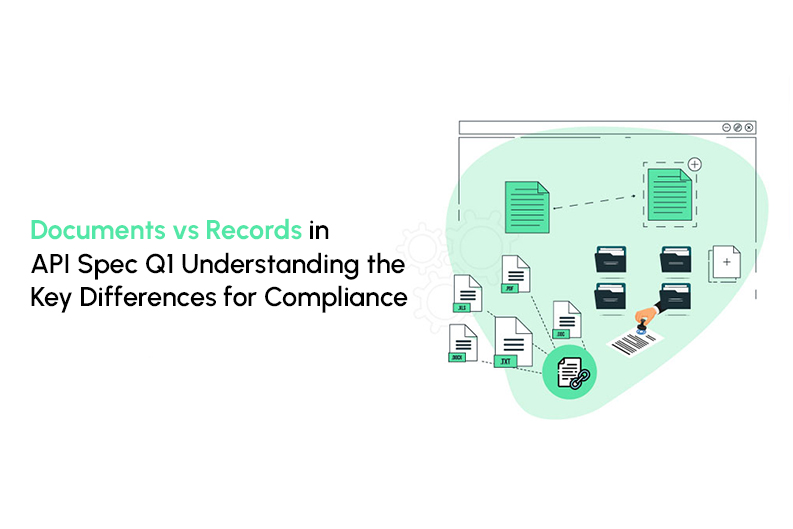In the oil and gas industry, compliance with API Spec Q1 is essential for ensuring that products and services meet the highest standards of quality and reliability. As with many quality management systems (QMS), API Spec Q1 distinguishes between documents and records, each serving a distinct purpose in the overall system. However, misunderstanding these two can lead to audit challenges and operational inefficiencies.
What Are Documents in API Spec Q1?
Documents are essential tools for defining procedures, guidelines, and policies within the scope of API Spec Q1. They describe how processes should be carried out, offering clarity and consistency across an organization’s operations. Documents guide employees and stakeholders to ensure that all activities comply with both internal and industry-specific standards.
– Purpose: Documents serve to communicate how activities should be performed, and they guide actions to ensure compliance with API Spec Q1 requirements.
– Nature: They are dynamic—subject to updates and revisions as processes evolve and improve.
– Example in API Spec Q1: A quality manual outlining the overall framework of the QMS, or a procedure document specifying how internal and external audits should be conducted.
What Are Records in API Spec Q1?
Records, on the other hand, serve as evidence that tasks have been completed in line with API Spec Q1. They capture and store the outcomes of processes and activities, providing historical data to verify compliance and performance.
– Purpose: Records provide proof that specific tasks or procedures have been performed according to API Spec Q1 requirements.
– Nature: Records are static once created and serve as historical data for audits and reviews.
– Example in API Spec Q1: Completed calibration records, inspection reports, or test certificates that verify specific tasks were completed in accordance with the requirements.
Key Differences Between Documents and Records in API Spec Q1
The distinction between documents and records is fundamental to maintaining an effective QMS under API Spec Q1. Here are the major differences:
- Purpose:
– Documents: Guide actions by providing clear instructions or procedures (e.g., how to conduct a supplier evaluation).
– Records: Serve as proof that actions have been completed or processes performed (e.g., a record of the completed supplier evaluation)
- Flexibility:
– Documents: Can be updated as necessary to accommodate changes in processes or regulatory requirements.
– Records: Once created, they remain unchanged and are maintained as evidence of past actions.
- Timing of Use:
– Documents: Typically created before an action is taken to guide that action.
– Records: Created after an action is completed to document that it occurred.
Why the Difference Matters for API Spec Q1 Compliance
In API Spec Q1, both documents and records play critical roles, but they serve different functions. Documents ensure that processes are executed in compliance with the standard, providing the necessary procedures, manuals, and guidelines to achieve consistent quality. Records, on the other hand, provide proof that these processes have been carried out as required.
When preparing for an API Spec Q1 audit, accurate documentation and complete records are essential. Documents provide the blueprint for compliance, while records verify that compliance has been maintained. Failing to distinguish between the two can lead to non-conformities, missed requirements, or an incomplete audit trail. For more insights on effective audit preparation, explore our detailed auditing services here.
How to Manage Documents and Records in API Spec Q1
To ensure smooth audits and maintain compliance with API Spec Q1, companies must effectively manage both their documents and records:
– Document Control: All documents, such as manuals and procedures, should be reviewed and updated regularly to ensure they reflect current requirements and operational practices. Use version control to manage updates and ensure only the latest versions are available to personnel.
– Record Retention: Records, such as inspection reports, calibration certificates, and training logs, should be stored securely and retained for a period that meets both regulatory and operational needs. A strong records retention policy helps ensure easy access during audits and reviews.
– Digital Tools: Using digital systems like Vegas ConnIT can streamline both document and record management, allowing for better traceability, easy access, and automated workflows, all of which are crucial for API Spec Q1 compliance.
Conclusion
While documents and records might seem similar, their roles within an API Spec Q1 quality management system are fundamentally different. Documents provide the framework for compliance by guiding actions, while records offer proof that those actions were taken as required. Both are need to the success of your QMS and the ability to meet the high standards set by API Spec Q1.
Are you looking for expert assistance in achieving or maintaining API Spec Q1 compliance? At Vegas Consulting, we specialize in helping oil and gas companies manage their quality systems, ensuring seamless audits and long-term compliance. Contact us today. to learn how we can support your API certification journey.
